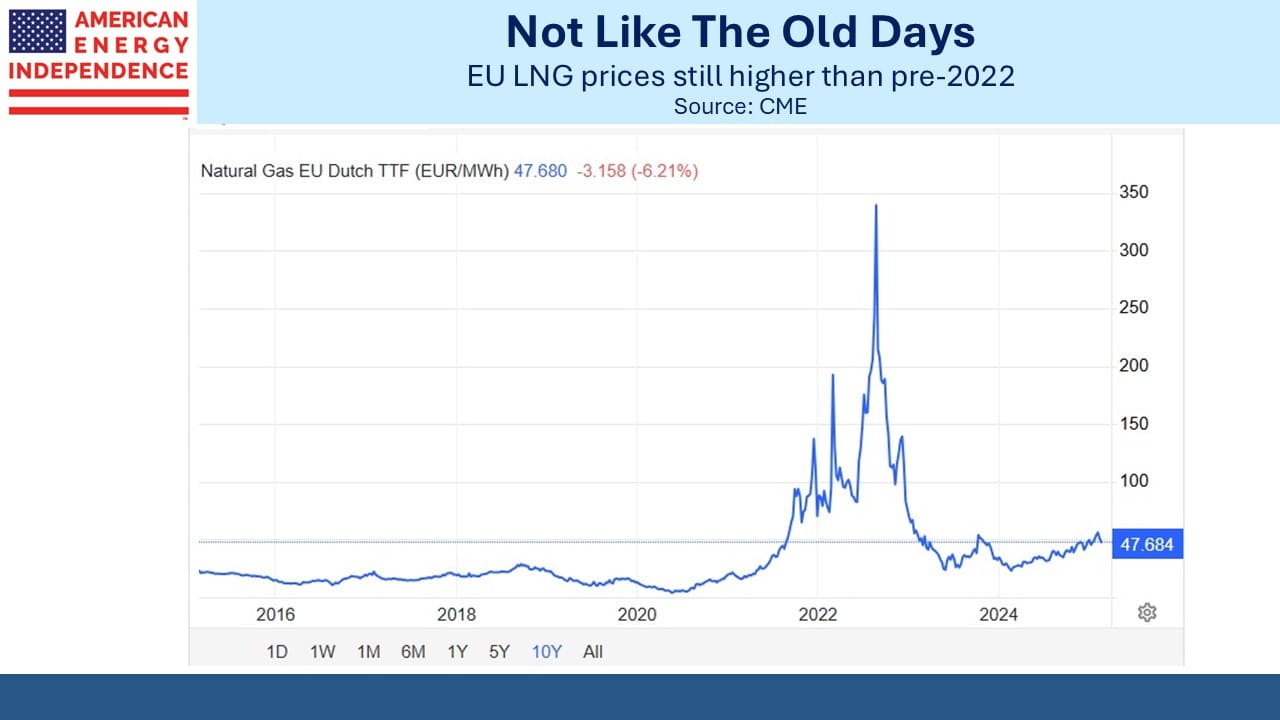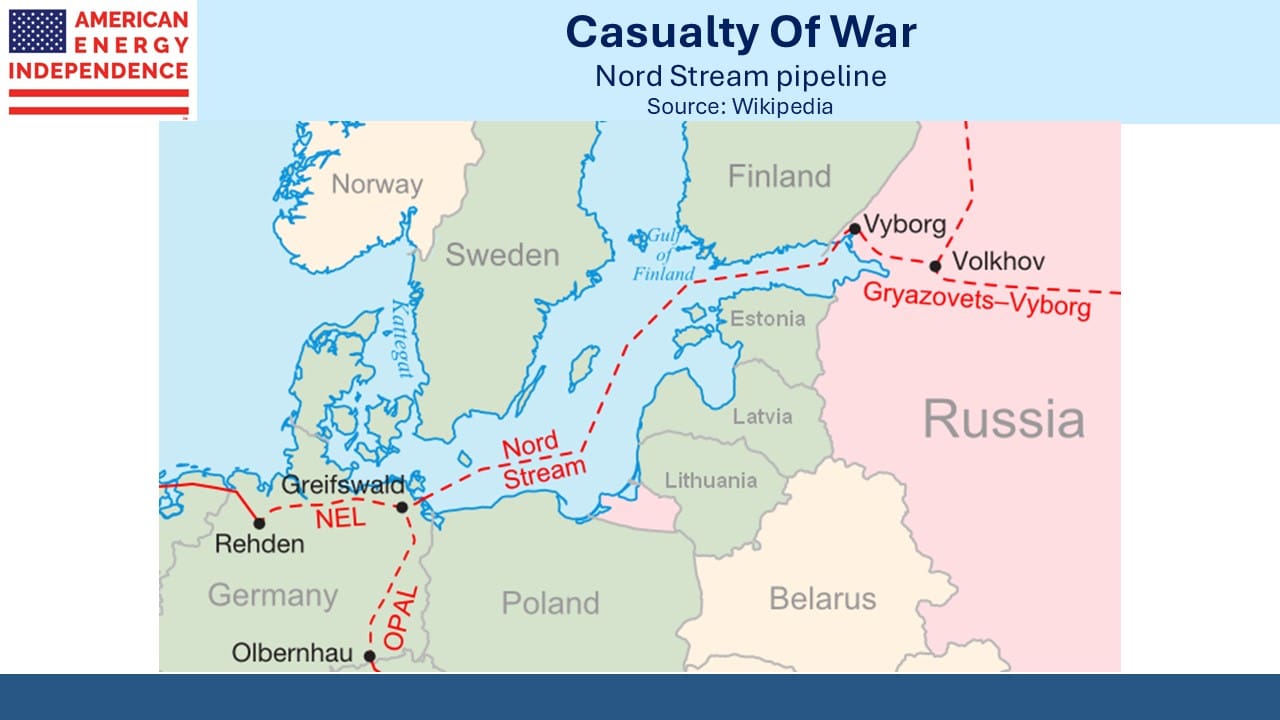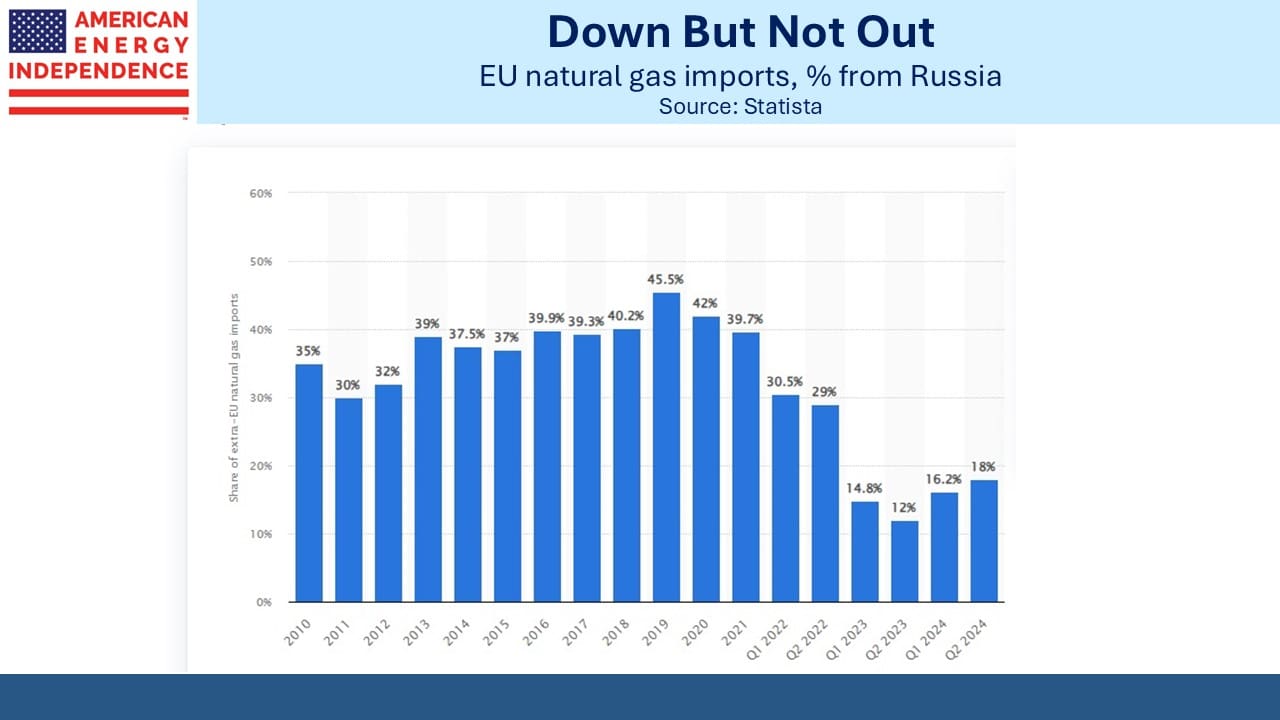Will Europe Feed The Crocodile?

/
Among Winston Churchill’s many memorable quotes is, “An appeaser is one who feeds a crocodile, hoping it will eat him last.”
This applies to some European countries’ posture towards Russia. The Economist recently asked, Will Europe return to Putin’s gas? Could they return to their reliance on Russian energy? The question has been buffeting LNG stocks in recent days. It would appear inconceivable that the continent should go back down that road, after Russia weaponized its gas supply following the invasion of Ukraine.
Volumes through Nord Stream gradually fell throughout 2022 until an explosion ruptured three of the four pipes that make up Nord Stream 1 and 2 in September. Germany scrambled to lease Floating Storage and Regasification Units (FSRUs). Europe’s LNG benchmark TTF soared by over 10X.
Even today, the TTF benchmark trades at over $15 per Million BTUs (MMBTUs) versus $3.60 in the US.
High energy prices are a headwind to GDP growth. Euro-area growth of 0.7% last year and this compares unfavorably with the US which is chugging along at 2.8%. Europe has lagged the US for many years and their green energy policies are partly to blame for persistent underperformance.
Germany has the worst energy policies of any country (see Germany’s Costly Climate Leadership). Their energy transition, or “Energiewende” has seen a huge focus on solar and wind even while they’ve shut down nuclear. Dependence on Russian gas was another strategic blunder. They’ve even coined “dunkelflaute”, the name for cloudy, calm days when renewables are just expensive junk. Germany has endured periods of dunkelflaute in recent years, forcing them to use more coal and gas (see Lemming Leadership).
Gas prices have remained high since the invasion. This has caused many companies to complain that they can no longer manufacture profitably in Germany (see Germany Pays Dearly For Failed Energy Policy).
Russian gas imports have fallen but not disappeared. Europe’s stance towards Ukraine’s efforts to repel its invader is one of qualified support. They’re providing money and certain weapons in a calibrated manner intended to avoid causing too great offense. They’d like to constrain Russian energy exports but still need some natural gas so prices don’t go too high.
US direct negotiations with Russia over Ukraine therefore open the question of what Russian gas exports will look like following the end of hostilities. Much of the gas Russia used to send through Nord Stream has remained in place in Siberia, although they have been able to increase LNG exports.
Negotiations with China on building the Power of Siberia 2 pipeline have dragged on for years. This would more than double the pipeline’s current capacity, but China has shown little urgency to reach an agreement.
Since Europe never completely stopped buying Russian gas, they’d presumably be open to buying more. This has caused some to consider whether the sabotaged Nord Stream pipeline could be repaired and re-opened.
There’s no precedent for such a project. The pipeline runs from northern Russia across the Baltic to Germany. It’s made of steel 1.6 inches thick, with another 4.3 inches of concrete wrapped around them. There are around 100,000 sections of pipeline each weighing 24 metric tonnes.
Following the explosion in 2022 three of the four pipelines flooded with seawater. It’s not clear this could ever be restored to service. The pipelines have been suffering corrosion for the past two and a half years. Repairs would mean either replacing the damaged sections or patching them up in place.
This would require specialized ships with cranes strong enough to lift the components. The pipeline would then need to be laboriously inspected along its entire length. Scores of divers would be required. Much of the pipeline lies at depths of 250-300 feet.
The seawater would need to be pumped out, not a trivial task since the pumps and compression stations were designed to move natural gas, not much heavier water.
Two years ago the owners (majority owner Gazprom along with Wintershall, Engie, Gasunie and E.ON) met to discuss how to preserve the pipeline for possible re-use in the future. E.ON has already written its stake to zero. It’s currently mothballed. Many observers think it’s beyond repair.
Assuming technical solutions could be implemented to restore gas supplies on Nord Stream, would this mean a political agreement? In his first term President Trump railed against Germany’s planned construction of Nord Stream, rightly asking why US troops were stationed in Germany offering a defense again their gas supplier.
It’s hard to imagine Europe increasing gas imports from Russia without Trump raising the same issue. US LNG exports to Europe surged following the loss of Russian supply. It’s no exaggeration to say that America kept the lights on in Europe over the past couple of years. Nonetheless, so far this year Europe’s LNG imports from Russia are running at record levels.
Trump has been a vocal proponent of growing US oil and gas exports. He’s suggested to the EU that LNG exports could be linked to tariff negotiations.
Markets have been interpreting a Ukraine cease fire as causing Russian gas exports to Europe to displace those from the US. We don’t think that’s likely.
We have two have funds that seek to profit from this environment:

Important Disclosures
The information provided is for informational purposes only and investors should determine for themselves whether a particular service, security or product is suitable for their investment needs. The information contained herein is not complete, may not be current, is subject to change, and is subject to, and qualified in its entirety by, the more complete disclosures, risk factors and other terms that are contained in the disclosure, prospectus, and offering. Certain information herein has been obtained from third party sources and, although believed to be reliable, has not been independently verified and its accuracy or completeness cannot be guaranteed. No representation is made with respect to the accuracy, completeness or timeliness of this information. Nothing provided on this site constitutes tax advice. Individuals should seek the advice of their own tax advisor for specific information regarding tax consequences of investments. Investments in securities entail risk and are not suitable for all investors. This site is not a recommendation nor an offer to sell (or solicitation of an offer to buy) securities in the United States or in any other jurisdiction.
References to indexes and benchmarks are hypothetical illustrations of aggregate returns and do not reflect the performance of any actual investment. Investors cannot invest in an index and do not reflect the deduction of the advisor’s fees or other trading expenses. There can be no assurance that current investments will be profitable. Actual realized returns will depend on, among other factors, the value of assets and market conditions at the time of disposition, any related transaction costs, and the timing of the purchase. Indexes and benchmarks may not directly correlate or only partially relate to portfolios managed by SL Advisors as they have different underlying investments and may use different strategies or have different objectives than portfolios managed by SL Advisors (e.g. The Alerian index is a group MLP securities in the oil and gas industries. Portfolios may not include the same investments that are included in the Alerian Index. The S & P Index does not directly relate to investment strategies managed by SL Advisers.)
This site may contain forward-looking statements relating to the objectives, opportunities, and the future performance of the U.S. market generally. Forward-looking statements may be identified by the use of such words as; “believe,” “expect,” “anticipate,” “should,” “planned,” “estimated,” “potential” and other similar terms. Examples of forward-looking statements include, but are not limited to, estimates with respect to financial condition, results of operations, and success or lack of success of any particular investment strategy. All are subject to various factors, including, but not limited to general and local economic conditions, changing levels of competition within certain industries and markets, changes in interest rates, changes in legislation or regulation, and other economic, competitive, governmental, regulatory and technological factors affecting a portfolio’s operations that could cause actual results to differ materially from projected results. Such statements are forward-looking in nature and involves a number of known and unknown risks, uncertainties and other factors, and accordingly, actual results may differ materially from those reflected or contemplated in such forward-looking statements. Prospective investors are cautioned not to place undue reliance on any forward-looking statements or examples. None of SL Advisors LLC or any of its affiliates or principals nor any other individual or entity assumes any obligation to update any forward-looking statements as a result of new information, subsequent events or any other circumstances. All statements made herein speak only as of the date that they were made. r
Certain hyperlinks or referenced websites on the Site, if any, are for your convenience and forward you to third parties’ websites, which generally are recognized by their top level domain name. Any descriptions of, references to, or links to other products, publications or services does not constitute an endorsement, authorization, sponsorship by or affiliation with SL Advisors LLC with respect to any linked site or its sponsor, unless expressly stated by SL Advisors LLC. Any such information, products or sites have not necessarily been reviewed by SL Advisors LLC and are provided or maintained by third parties over whom SL Advisors LLC exercise no control. SL Advisors LLC expressly disclaim any responsibility for the content, the accuracy of the information, and/or quality of products or services provided by or advertised on these third-party sites.
All investment strategies have the potential for profit or loss. Different types of investments involve varying degrees of risk, and there can be no assurance that any specific investment will be suitable or profitable for a client’s investment portfolio.
Past performance of the American Energy Independence Index is not indicative of future returns.





It’s absolutely rich of you to challenge Europe for its appeasement of Russia through gas purchases when Trump yesterday is rewriting history and sacrificing Ukraine to do the same thing. Shades of Chamberlain in 1937. Shame on you. Shame on Trump. Shame on anyone who indulges Putin.